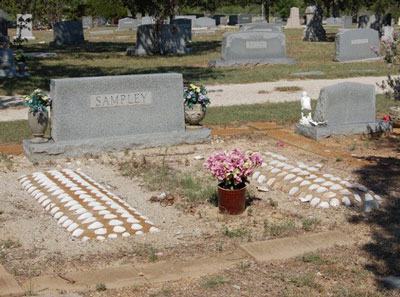
Graves of my relatives buried at Cottonwood Cemetery east of Bryson, Jack County, Texas. Not only did the family keep the graves swept, they place shells over them to be certain no weeds grew there. Photograph taken ca. 1995. (Author’s collection)
Tomorrow is Memorial Day, but do you know the story behind the event? There’s more to it than celebrating the beginning of summer, the end of school, and spending time at the lake. It was first observed in May 1865, immediately after the surrender of General Robert E. Lee to General U. S. Grant. There were even some skirmishes still going on in the Trans-Mississippi District where news was slow to arrive.
Women in the South wanted to bury their dead and preserve their memory in the cemetery. They cleaned the grounds, gathered flowers, and solemnly prayed for their loved ones. It wasn’t long before the women in the North followed the example. It became a day to honor and remember those who died for their country. The custom continues today. We honor those who served in the military and are still living on Veterans’ Day, November 11.
Here in Northeast Texas we have burial traditions unlike other parts of the nation. Subsistence farmers settled our section of the country very early. Most came through Missouri and Arkansas before spreading out along the Red River and into the interior of Texas.
In sparsely populated areas, the deceased were buried near the home. As the population grew, someone donated land for the cemetery. The idea of creating a cemetery before needed met with superstition. Would it bring an early death to the donor?
Fences enclosed the cemetery and often some family plots were also fenced. Graves were on an east-west axis so the deceased could rise to the morning sun and face Jerusalem. Graves located outside the fence were those of outlaws. The best place to locate a cemetery was on a higher ground, a slight rise. But if that was superior farmland, the family or community might choose a smaller, less valuable site. Some graves were located near a creek to make certain the cotton or other crops were not destroyed by a heavy rainstorm or flood.
Churchyards are seldom gravesites in Northeast Texas. I know of one family whose child died in the summer when the blackland clay was as hard as a rock. They buried the child at the edge of the family garden, the only place to dig deep.
Many cemeteries were entered through a litch-gate, the gate in which a wagon carrying the casket moved to the burial site. Mourners followed on foot. Sometimes the cemetery had a brush arbor for funerals or revivals.
On a selected date everyone in the community arrived with hoes and rakes and other garden tools. Buckets hauled water. Women brought covered dishes of delicious food. After a severe cleaning of the graveyard, everyone gather for a meal and lots of visiting. Some cemeteries held grave cleaning days in the spring and again in the fall.
In Northeast Texas until the use of motorized lawn mowers, it was common to find swept graves. The family of a cotton farmer remembered how he wanted the fields cleared meticulously of weeds felt he would not want any weeds over his grave. They honored his wish by keeping his grave swept clean with a broom.
